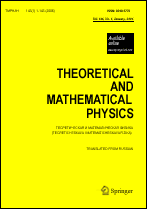|
This article is cited in 24 scientific papers (total in 24 papers)
Anyons and the Bose–Fermi duality in the finite-temperature Thirring model
N. Ilievaabc, W. Thirringa
a Institute for Nuclear Research and Nuclear Energy, Bulgarian Academy of Sciences
b International Erwin Schrödinger Institute for Mathematical Physics
c University of Vienna
Abstract:
Solutions to the Thirring model are constructed in the framework of algebraic quantum field theory. Fermionic solutions exist for all positive temperatures only if the coupling constant is $\lambda=\sqrt{2(2n+1)\pi}$, $n\in\mathbb Z$. These fermions are not equivalent and become canonical fields only for $n=1$. In the general case, the solutions are anyons. Different anyons (uncountably many) exist in orthogonal spaces and satisfy dynamic equations (of the Heisenberg “Urgleichung” type) characterized by corresponding values of the statistical parameter, which, in turn, is related to the coupling constant $\lambda$. The whole Hilbert space becomes nonseparable with a different Urgleichung satisfied in each sector. This feature is absent from any power expansion in $\lambda$, which, being related to the statistical parameter, definitely fails and never reveals the true structure of the theory. The correlation functions in the temperature state for canonically dressed fermions coincide with the ones for the bare fields. This is in agreement with the uniqueness of the $\tau$-Kubo–Martin–Schwinger state over the canonical anticommutation relation algebra ($\tau$ being the shift automorphism). The $\alpha$-anyon two-point function is computed and reproduces the previously known result for a scalar field.
Received: 09.06.1999
Citation:
N. Ilieva, W. Thirring, “Anyons and the Bose–Fermi duality in the finite-temperature Thirring model”, TMF, 121:1 (1999), 40–65; Theoret. and Math. Phys., 121:1 (1999), 1294–1314
Linking options:
https://www.mathnet.ru/eng/tmf797https://doi.org/10.4213/tmf797 https://www.mathnet.ru/eng/tmf/v121/i1/p40
|


| Statistics & downloads: |
| Abstract page: | 335 | | Full-text PDF : | 178 | | References: | 42 | | First page: | 1 |
|




 Contact us:
Contact us: Terms of Use
Terms of Use
 Registration to the website
Registration to the website Logotypes
Logotypes








 Citation in format
Citation in format 
